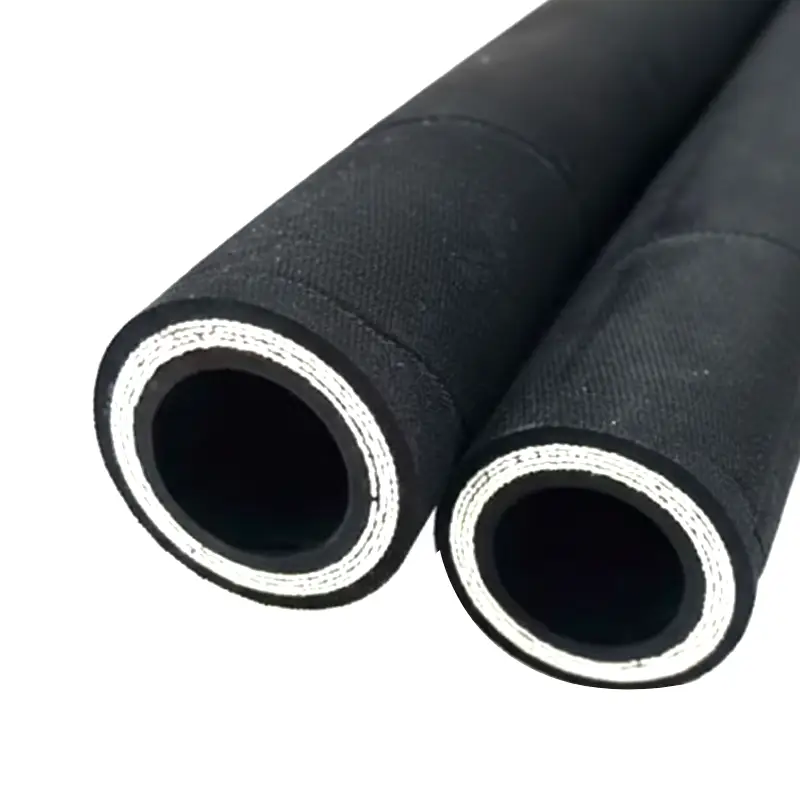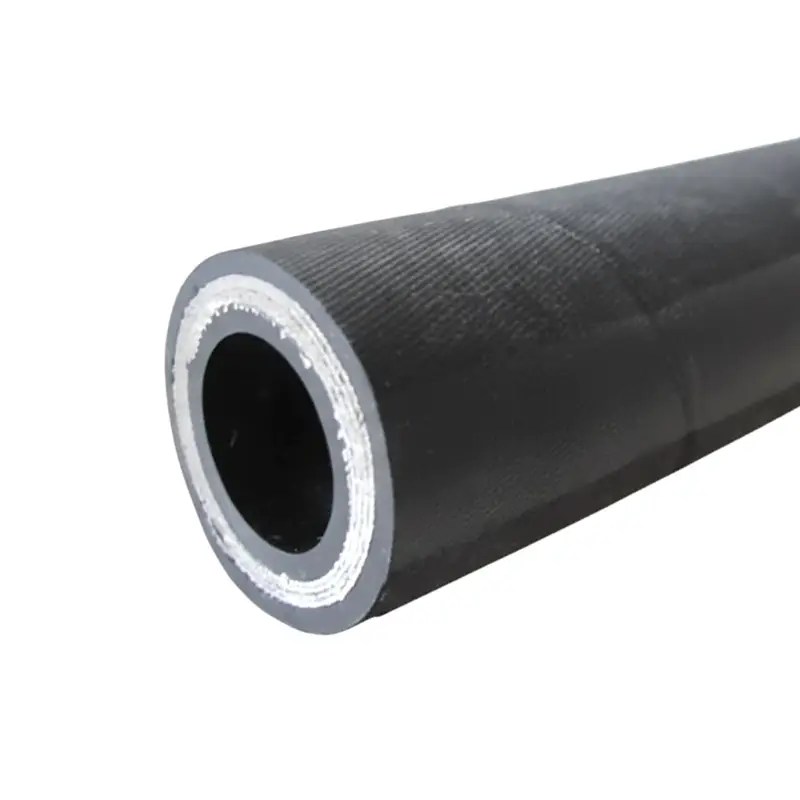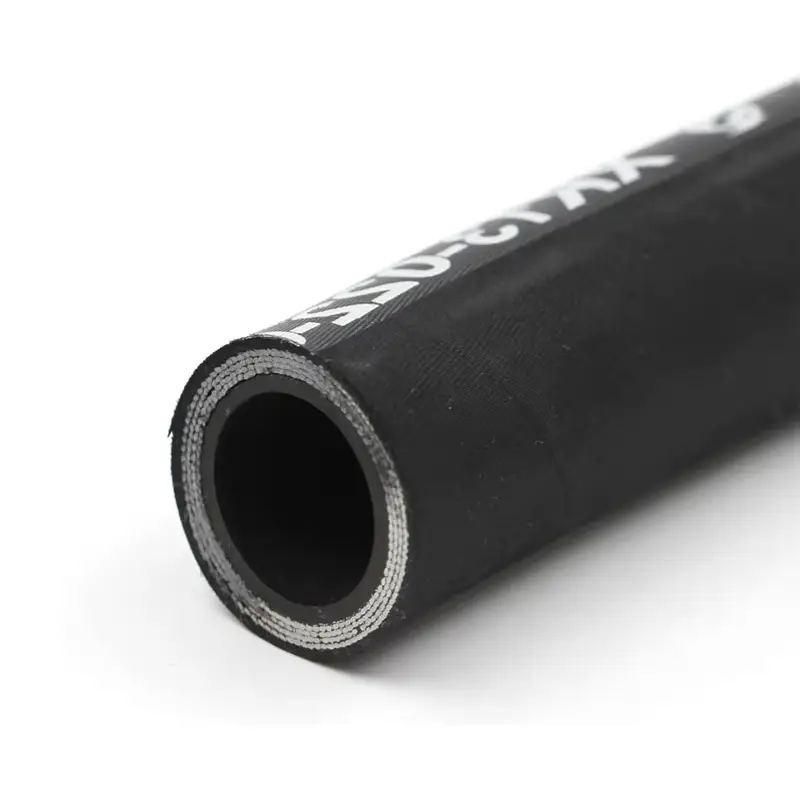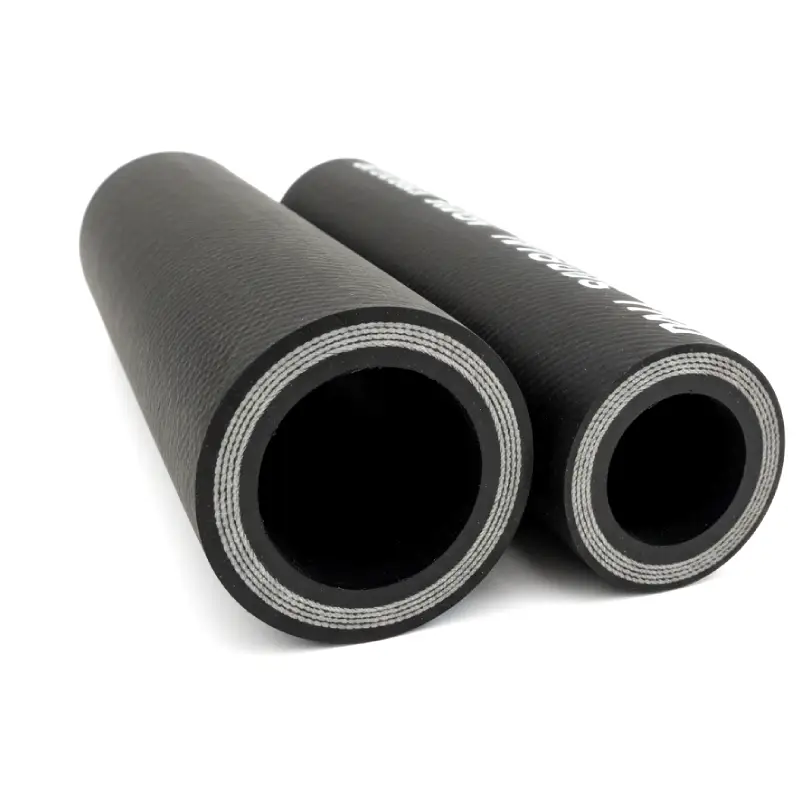We provide steel reinforced hydraulic hoses designed for high-pressure hydraulic systems. Built with strong steel wire layers, our hoses deliver excellent durability, flexibility, and resistance to wear. Ideal for industrial, construction, and heavy-duty applications, they ensure reliable performance, minimize downtime, and maintain safety under demanding operating conditions.
High Pressure Resistance: Our steel reinforced hydraulic hoses withstand extreme pressure, ensuring reliable fluid transmission without bursting. They maintain consistent performance in hydraulic machinery and industrial systems under heavy-duty operating conditions.
Durable Construction: Made with multiple layers of steel wire and premium rubber, these hoses resist abrasion, impact, and environmental stress, providing long-lasting reliability in harsh industrial and mechanical applications.
Flexibility and Versatility: Despite their reinforced design, our hoses remain flexible, allowing easy routing in tight spaces while accommodating various machinery, vehicles, and industrial equipment installations.
Temperature and Chemical Resistance: These hoses handle wide temperature ranges and exposure to hydraulic fluids or chemicals, ensuring safe and efficient operation across diverse industrial and construction environments.
Easy Maintenance: Designed for longevity, steel reinforced hydraulic hoses reduce replacement frequency, minimize maintenance costs, and improve operational efficiency, making them a dependable choice for demanding hydraulic applications.
As a leading steel reinforced hydraulic hose manufacturer from China, we specialize in producing hydraulic hoses designed for high-pressure applications. Built with durable steel wire layers and premium materials, our hoses offer excellent strength, flexibility, and resistance to wear. They ensure reliable hydraulic system performance across industrial, construction, and heavy-duty equipment.

High Pressure Resistance: Steel reinforced hoses can withstand extreme hydraulic pressures, preventing bursts and leaks. This ensures continuous, safe fluid transmission and reliable operation in demanding systems.
Durable Construction: Built with steel wire layers and premium rubber, these hoses resist abrasion, impact, and environmental stress, extending service life and reducing the frequency of replacements.
Flexibility: Despite steel reinforcement, the hoses maintain flexibility, making installation in tight spaces easier while accommodating complex machinery layouts without compromising performance.
Temperature and Chemical Resistance: These hoses tolerate a wide range of temperatures and resist various hydraulic fluids and chemicals, ensuring safe and consistent performance under challenging conditions.
Cost Efficiency: Long-lasting durability reduces maintenance, replacement frequency, and downtime, offering a cost-effective solution for hydraulic systems across industrial, construction, and heavy machinery applications.
Construction Machinery: These hoses provide reliable fluid transmission in excavators, loaders, and cranes, handling high pressures while resisting abrasion, impact, and environmental stress for consistent heavy-duty operation.
Industrial Equipment: Steel reinforced hoses are used in presses, injection molding machines, and other industrial machinery to ensure safe and efficient hydraulic performance under high-pressure workloads.
Agricultural Machinery: Used in tractors, harvesters, and irrigation systems, these hoses transmit hydraulic power reliably, enduring harsh outdoor conditions, pressure fluctuations, and long operational hours in agricultural applications.
Automotive Applications: Ideal for hydraulic brakes, steering systems, and suspension components, steel reinforced hoses maintain fluid integrity, resist pressure spikes, and ensure vehicle safety and optimal performance.
Marine and Offshore Equipment: These hoses handle high-pressure hydraulic systems on ships, rigs, and offshore machinery, providing durability, corrosion resistance, and reliable operation in demanding marine environments.

We offer reinforced hydraulic hoses designed to handle high-pressure applications with durability and reliability. Constructed with steel wire layers and premium rubber, our hoses resist abrasion, impact, and environmental stress. Ideal for industrial, construction, automotive, and heavy machinery, they ensure safe, efficient fluid transmission, extend hose life, and reduce maintenance needs.

We offer hydraulic hoses with steel reinforcement designed for high-pressure hydraulic systems. Built with durable steel wire layers and premium rubber, these hoses provide excellent strength, flexibility, and resistance to wear. Ideal for industrial, construction, automotive, and heavy machinery applications, they ensure reliable performance, safety, and extended hose life in demanding environments.

We offer steel wire reinforced hydraulic hoses designed for high-pressure hydraulic systems. With multiple steel wire layers and premium rubber construction, our hoses provide superior strength, flexibility, and resistance to wear and abrasion. Ideal for industrial, construction, automotive, and heavy machinery applications, they ensure reliable performance, extended hose life, and safe operation.

We offer steel wire braided hydraulic hoses designed for high-pressure hydraulic systems. Constructed with multiple layers of steel wire and premium rubber, these hoses provide excellent strength, flexibility, and durability. Ideal for industrial, automotive, and heavy machinery applications, they ensure reliable fluid transmission, resist abrasion, extend service life, and maintain safe operation under demanding conditions.
We understand that every hydraulic system has unique requirements, so we customize our steel reinforced hydraulic hoses to meet your specific needs. By focusing on size, pressure rating, material, and end fittings, we ensure our hoses deliver optimal performance, durability, and safety, keeping hydraulic systems reliable and efficient in demanding environments.
We provide steel reinforced hydraulic hoses in various diameters and lengths tailored to your system requirements. This ensures a precise fit, smooth fluid flow, and reliable performance, reducing stress on hoses and preventing leaks or premature failure.
We provide hoses in various diameters and lengths to match your vehicle’s brake system layout. Customizing these dimensions ensures proper air flow, easy installation, and reliable braking performance in every application.
We use rubber compounds and steel wire layers based on your operational needs. This customization provides optimal abrasion resistance, flexibility, chemical resistance, and durability, ensuring hoses withstand demanding industrial, automotive, or heavy machinery environments.
We adjust the hose design and materials to handle specific temperature ranges. This ensures consistent hydraulic performance in extreme hot or cold conditions, protecting hoses from heat damage or freezing while maintaining safety and system efficiency.
A steel reinforced hydraulic hose is a high-pressure hose designed for transmitting hydraulic fluids in industrial, automotive, and heavy machinery applications. It consists of multiple layers of steel wire braided into durable rubber or synthetic tubing, providing superior strength, flexibility, and resistance to wear, abrasion, and pressure.
Steel reinforced hydraulic hoses are essential in systems where reliability and safety are critical. They prevent hose failure under high-pressure conditions, ensure consistent fluid flow, and extend service life. Widely used in hydraulic machinery, construction equipment, and automotive systems, these hoses maintain performance in demanding environments while reducing maintenance costs and operational downtime.
Steel reinforced hydraulic hoses are constructed from high-quality materials designed to withstand high pressure, abrasion, and harsh environmental conditions. Combining durable rubber or synthetic inner tubes with braided steel wire layers, these hoses provide strength, flexibility, and long-lasting performance for industrial, automotive, and heavy machinery hydraulic systems.
Inner Tube: The inner tube is made from oil-resistant synthetic rubber or thermoplastic, ensuring smooth fluid flow, chemical compatibility, and protection against hydraulic fluids, pressure fluctuations, and environmental factors for safe and efficient system operation.
Reinforcement Layer: Multiple layers of high-tensile steel wire are braided around the inner tube. This reinforcement provides strength, pressure resistance, and durability, allowing the hose to handle high-pressure hydraulic applications without bursting or deforming.
Outer Cover: The outer layer is constructed from abrasion-resistant rubber or synthetic material. It protects the hose from external damage, environmental stress, UV exposure, and wear, ensuring long service life in demanding industrial and automotive conditions.
Adhesive Layers: Special bonding layers are used between the inner tube, steel wire, and outer cover. These adhesives ensure structural integrity, prevent delamination, and maintain consistent performance under high-pressure and dynamic operating conditions.
Optional Coatings: Some steel reinforced hydraulic hoses include additional protective coatings or wraps, such as PVC or thermoplastic layers, to enhance chemical resistance, UV protection, or abrasion resistance for specific application requirements.
Steel reinforced hydraulic hoses are used to transmit hydraulic fluids under high pressure in industrial, automotive, construction, and heavy machinery applications. They provide reliable performance, resist abrasion and pressure, and ensure safe, efficient operation in demanding environments, reducing maintenance needs and extending system life.
Construction Equipment: These hoses power hydraulic systems in excavators, loaders, cranes, and other heavy machinery. They withstand high pressure, prevent fluid leaks, and ensure reliable operation under demanding working conditions.
Industrial Machinery: Steel reinforced hoses are used in presses, injection molding machines, and factory hydraulic systems. They provide safe fluid transmission, resist wear, and maintain consistent performance in high-pressure industrial applications.
Automotive Applications: Ideal for power steering, braking, and suspension systems, these hoses maintain fluid integrity, resist pressure spikes, and ensure vehicle safety and smooth performance under varying operating conditions.
Agricultural Machinery: Used in tractors, harvesters, and irrigation systems, these hoses transmit hydraulic power reliably, handle outdoor conditions, and endure long operational hours without failure, ensuring efficiency in agricultural operations.
Marine and Offshore Equipment: Steel reinforced hydraulic hoses withstand high-pressure systems on ships, offshore rigs, and marine machinery. They resist corrosion, mechanical stress, and harsh environmental conditions, ensuring durability and consistent hydraulic performance.
Choosing our steel reinforced hydraulic hoses ensures reliable performance, durability, and safety for high-pressure hydraulic systems. Designed for industrial, automotive, construction, and heavy machinery applications, our hoses resist wear, abrasion, and pressure spikes, extending service life, minimizing downtime, and maintaining consistent fluid transmission under demanding conditions.
Superior Strength: Our hoses feature multiple layers of high-tensile steel wire and premium rubber or synthetic inner tubes. This construction provides exceptional pressure resistance, durability, and protection against bursts, ensuring safe operation in demanding hydraulic systems.
High Pressure Performance: Engineered for high-pressure applications, these hoses maintain consistent fluid flow and prevent leakage. They perform reliably under extreme pressure fluctuations, ensuring safety, efficiency, and long-term stability across various hydraulic systems.
Durable Materials: Made with abrasion-resistant outer covers and oil-resistant inner tubes, our hoses withstand environmental stress, friction, chemicals, and UV exposure, providing long-lasting protection and reducing maintenance needs in harsh industrial and automotive environments.
Versatile Applications: Suitable for industrial machinery, construction equipment, automotive systems, agricultural machinery, and marine equipment, our hoses deliver reliable hydraulic performance across diverse industries and demanding operational conditions.
Customizable Solutions: We offer hoses with tailored sizes, pressure ratings, materials, and end fittings. This customization ensures optimal performance, seamless system integration, and maximum protection for specific hydraulic applications.